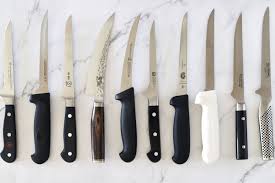Introduction
A boning knife is an essential tool for anyone serious about their culinary skills, especially when working with meat, poultry, or fish. This guide will explore the key features of boning knives, the different types available, and best practices for their use, ensuring you choose the right tool for your kitchen.
What is a Boning Knife?
A boning knife, a vital tool among kitchen knives, is specially designed for removing bones from meat, poultry, and fish. It is characterized by its narrow, pointed blade, which allows for precise cuts close to the bone. The blade typically ranges from 5 to 7 inches in length and is often curved to facilitate more natural cutting motions.
Types of Boning Knives
- Stiff vs. Flexible Blades: Stiff blades are ideal for tougher meats like beef, providing control and strength. Flexible blades, on the other hand, are perfect for delicate tasks like filleting fish, where precision and flexibility are required.
- Curved vs. Straight Blades: Curved blades allow for smoother, more efficient cutting around bones, while straight blades offer more control for detailed tasks.
- Size Variations: The size of the blade can vary, with shorter blades offering more control and longer blades providing better reach.
Key Features to Look For
- Blade Material: The material of the blade is crucial for performance and durability. Stainless steel is popular for its corrosion resistance, while carbon steel offers superior sharpness but requires more maintenance.
- Handle Design: A comfortable, ergonomic handle ensures better grip and reduces fatigue during extended use. Look for handles made from durable materials like wood, plastic, or composite.
- Weight and Balance: The knife should feel balanced in your hand, with the weight distributed evenly between the blade and handle. This balance enhances control and precision during use.
Best Practices for Using a Boning Knife
- Proper Technique: Always use a boning knife with a slicing motion rather than sawing. Keep the blade close to the bone, using the tip for detailed cuts.
- Maintenance Tips: Regular sharpening is essential to maintain the knife’s edge. Hand wash the knife and dry it immediately to prevent rust and corrosion.
- Safety Considerations: Always cut away from your body, and use a stable cutting surface to minimize the risk of accidents.
Boning Knife vs. Fillet Knife: What’s the Difference?
While both knives may appear similar, a boning knife is primarily used for separating meat from bones, whereas a fillet knife is designed for filleting fish. The fillet knife typically has a thinner, more flexible blade, ideal for delicate tasks.
How to Choose the Right Boning Knife for You
- Consider Your Needs: Think about the types of meat you frequently work with. For larger cuts, a stiffer, longer blade might be more suitable, while a flexible, shorter blade could be better for poultry or fish.
- Budget Considerations: Boning knives can range from budget-friendly options to high-end models. Determine your budget and prioritize features like blade material and handle comfort.
Conclusion
Choosing the right boning knife is crucial for anyone looking to enhance their kitchen skills. Consider the key features, types, and best practices outlined in this guide to make an informed decision. With the right knife, you’ll find meat preparation more efficient and enjoyable.





